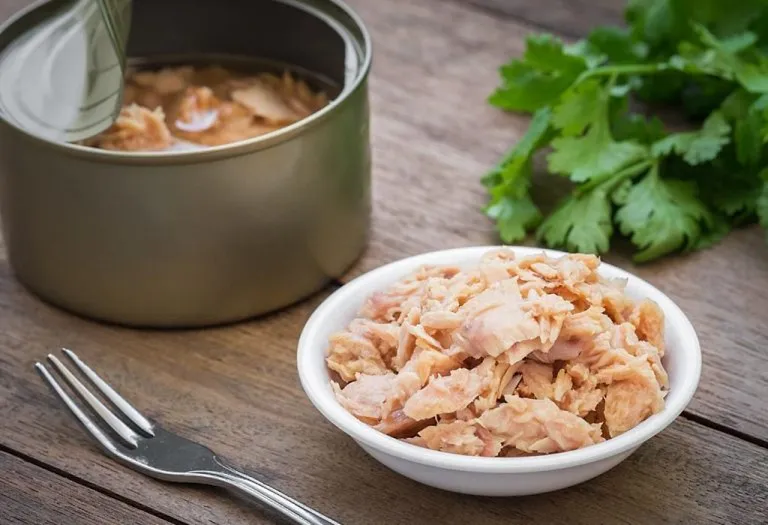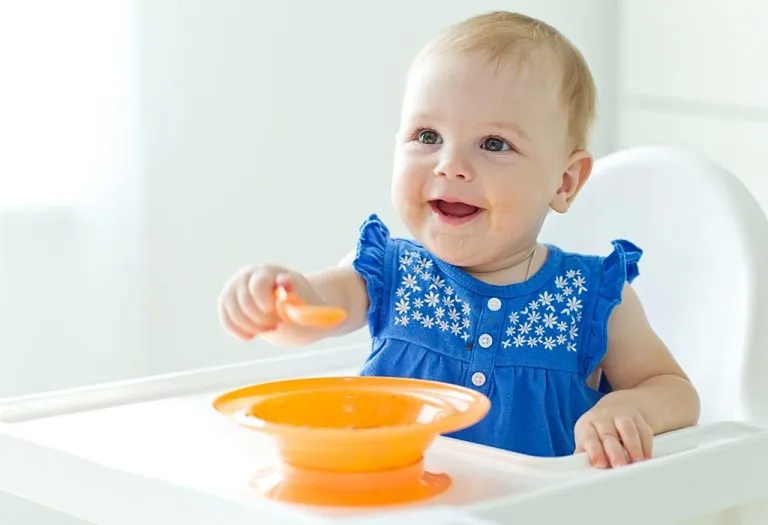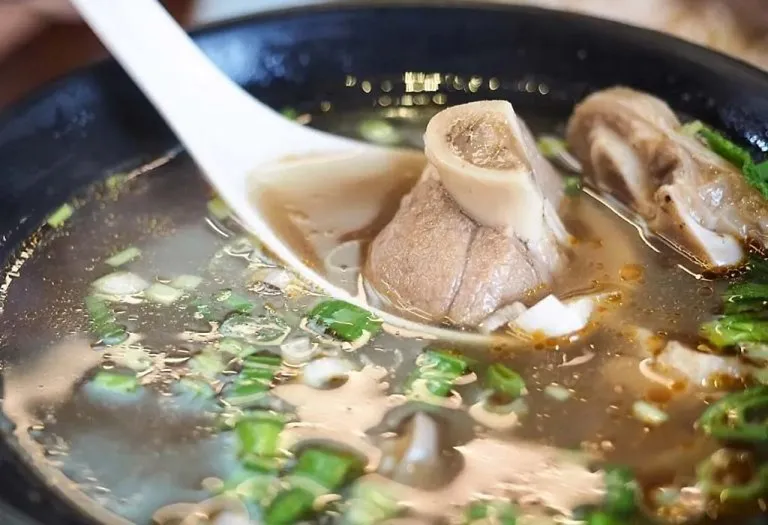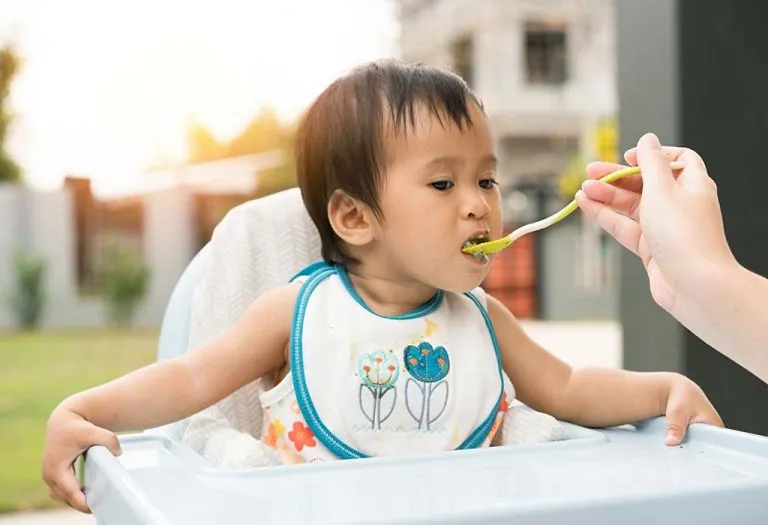Can Babies Eat Tuna? – Benefits & Risks

- Can Infants Eat Tuna?
- When Can Babies Eat Tuna?
- Nutrients Available in Tuna
- Health Benefits of Tuna for Infants
- How to Prepare Tuna for Babies
- Steps to Take While Introducing Tuna to Babies
- Risks Associated With Giving Tuna to Infants
- Precautions You Should Take While Giving Tuna to Your Young Child
- Easy Tuna Recipes for Babies
- FAQs
Tuna is filled with essential nutrients that support the maintenance and growth of the body. It is a rich source of proteins and Omega-3 fatty acids, which help protect the body from heart diseases and cancer. These nutrients also contribute to brain health, making it a valuable addition to the diet. However, mercury exposure is a significant concern regarding tuna fish, especially for infants and young children. It is important to ensure that age-appropriate servings of low-mercury fish, including tuna for infants, are offered in limited quantities. When consumed in moderation, tuna can be a safe and nutritious choice for babies and toddlers.
Can Infants Eat Tuna?
Fish is essential for the healthy growth and development of the baby. The most valid concern is mercury contamination. But if you give the baby very little portions that are appropriate for his age, tuna can prove to be very beneficial for his health. A wealth of nutrients can be supplied if your baby is provided with canned tuna.
When Can Babies Eat Tuna?
While deciding when to let your baby have tuna, you should be careful about the allergies it can cause. Although tuna isn’t really the type of seafood that can induce allergies, every person’s body reacts differently. Your child should have touched the six-month mark before you dish up tuna for any of his meals. Check if a small serving is causing any harmful reactions, and if not, you can definitely feed him tuna more often.
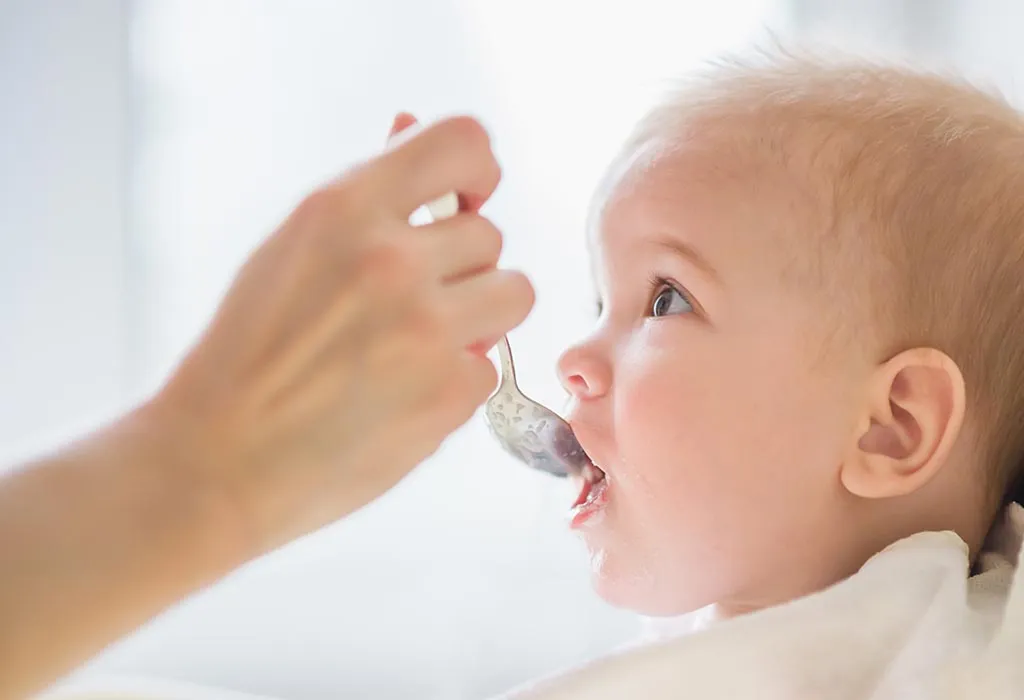
Nutrients Available in Tuna
The nutritional quotient of tuna is very high. Let’s take a look at the nutritional composition of 100 grams of fresh tuna.
| Nutrient | Amount | RDA |
| Energy | 109Kcal | |
| Water | 74.03g | |
| Protein | 24.4g | |
| Calcium | 4mg | 210mg (0-6 months) 270mg (7-12 months) |
| Phosphorus | 278mg | 100mg (0-6 months) 275mg (7-12 months) |
| Magnesium | 35mg | 30mg (0-6 months) 75mg (7-12 months) |
| Sodium | 45mg | 120mg (0-6 months) 200mg (7-12 months) |
| Potassium | 441mg | 500mg (0-6 months) 700mg (7-12 months) |
| Selenium | 90.6µg | 12µg |
| Niacin | 18.475mg | 5.4mg |
| Folate | 2µg | 24µg (0-6 months) 32µg (7-12 months) |
| Choline | 65µg | |
| Vitamin B12 | 2.08µg | 0.1µg |
| Vitamin D (D2 + D3) | 1.7µg | 10µg |
Health Benefits of Tuna for Infants
Can babies have canned tuna? As it happens, canned light tuna is considered best for infants! Omega 3 reduces joint pain and stiffness, promotes neurological development in children, and helps fight asthma. The rich content of proteins builds muscles and balances caloric content. It surely is a superfood to enjoy!
How to Prepare Tuna for Babies
Tuna can be a great source of protein and Omega-3 fatty acids for babies once they are ready to start solids. When introducing tuna, it’s important to consider the baby’s age and ensure the fish is prepared in a way that is safe and easy for them to eat.
For 6 Months Old
At 6 months, babies are just beginning to explore solid foods. The tuna should be well-cooked, and you should offer it as a puree or mixed with breast milk/formula to create a smoother consistency. Ensure there are no bones, and always serve in small amounts to gauge any potential allergic reactions.
For 9 Months Old
By 9 months, babies can handle slightly chunkier textures. You can mash or finely flake the tuna and mix it with soft vegetables like sweet potatoes or peas for added nutrients. It’s important to continue offering it in small, bite-sized pieces to avoid choking hazards.
For 12 Months Old
At 12 months, babies are ready for more solid foods. You can serve tuna as a finger food or mix it with other soft foods like avocado, mashed potatoes, or pasta. Make sure to offer small pieces that the baby can easily pick up and chew.
For 24 Months Old
By 24 months, toddlers can eat tuna in a variety of forms, such as in sandwiches, salads, or wraps. You can serve it flaked or even in small chunks, paired with their favorite vegetables or crackers. Just ensure the tuna is cooked well and served in age-appropriate portions.
Steps to Take While Introducing Tuna to Babies
A few essential steps are a must before you use tuna for baby food.
1. Use Only Thoroughly Cooked Tuna
As there is a great risk of bacteria, ensure that the canned tuna is thoroughly cooked. Care must be taken to ensure that there are no bones that the baby can choke on, and it’s easy for them to swallow.
2. The Intake Should Be Limited
Remember to buy canned tuna which is relatively safer for babies. Serving tuna in large quantities can harm the baby, so limit feeding the baby to twice a week only.
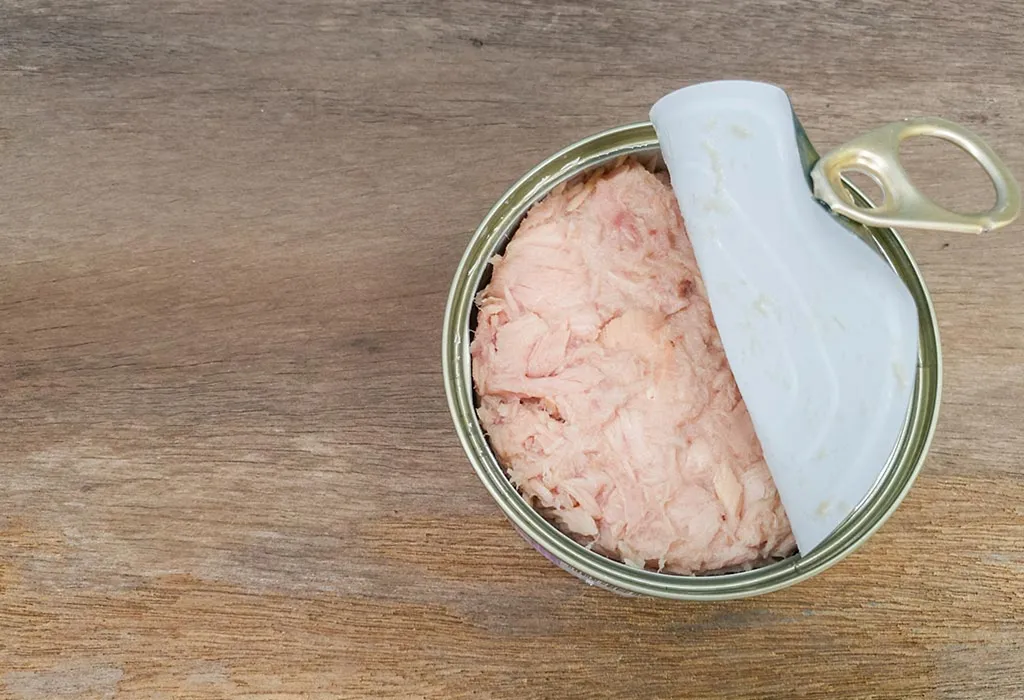
3. Keep a Watch on Allergies
Be watchful of allergies that can occur due to feeding tuna to babies. After eating tuna, if your baby has a rash on his lips or face or swelling of the tongue, then you should stop giving tuna. If your baby is vomiting, wheezing, has an upset stomach or diarrhoea, take him to the doctor as these are signs of allergy.
4. Add Vegetables With Tuna
The best way to make the dish enjoyable and nutritive is to combine the tuna with pureed vegetables to ensure your baby gets plenty of nutrients.
Risks Associated With Giving Tuna to Infants
Tuna may be contaminated with mercury which can harm the baby’s nervous system, which is the major risk or concern when it comes to feeding babies fish in general. If consumed in unhealthy quantities, it can result in neurological problems; hence, the stress on small servings once or twice a week only.
Precautions You Should Take While Giving Tuna to Your Young Child
Some precautions have to be taken to ensure the safe intake of tuna:
1. Remember That It Could Contain Mercury
Even within canned tuna, albacore (‘white’) tuna contains more levels of mercury than canned light tuna or skipjack. It’s safer to go for options with a lower content of mercury.
2. Consume Tuna After Short Intervals
While introducing tuna to your toddler, take it slow at first. Watch out for any seafood allergy and then give it again, and keep checking that your child does not show any symptoms of an allergy.
3. Try Other Types of Fish
If you wish to feed your child fish but are worried about the mercury content, you can try salmon too. Salmon has almost identical nutritive properties and makes for a great alternative.
4. Stick to Small Servings
For safety purposes, stick to age-appropriate servings.
Easy Tuna Recipes for Babies
Here are 3 recipes you can feed your little one once he has crossed 6 months of age and has started to develop a taste for solids:
1. Tuna Salad with Yogurt
Introduce tuna with this simple and easy recipe.
Ingredients
- 1 can of low-sodium light tuna
- ¼ cup organic whole milk or plain yoghurt
- 1 tbsp of fresh chopped or dried parsley
Method
- Collect the ingredients in a bowl and mix well.
- Mash it properly to ensure the baby can swallow the mixture easily.
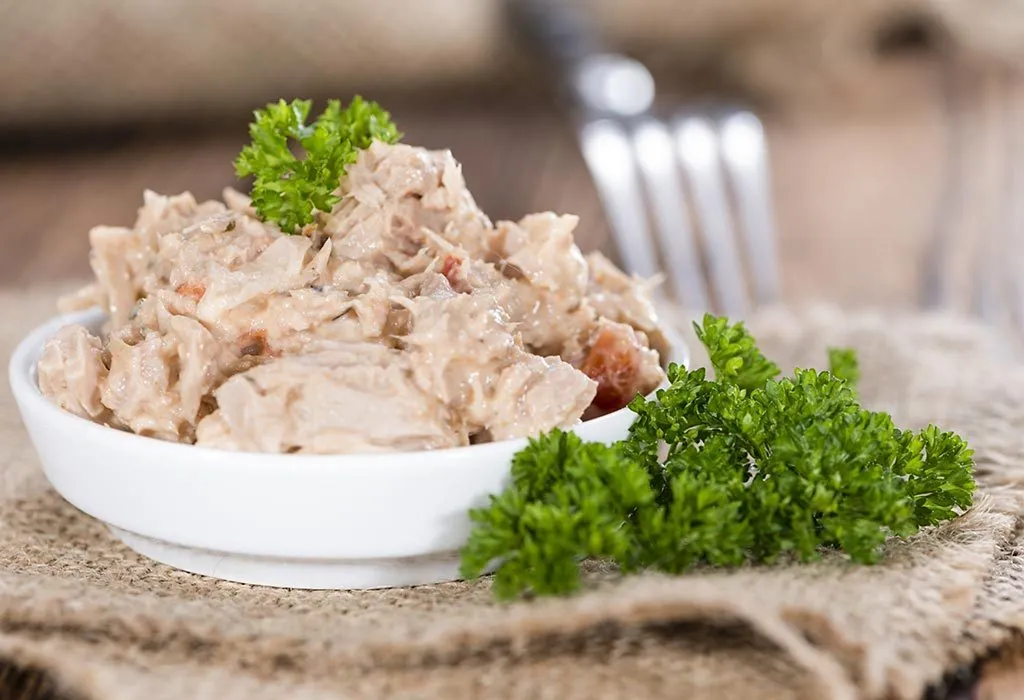
2. Tuna Cakes
Babies can enjoy small, bite-sized portions of this recipe, but this can be a great treat for all members of the family!
Ingredients
- 1 can tuna
- Breadcrumbs
- 1 egg
- 2 small potatoes
- ½ onion chopped
Method
- Boil the potatoes first and mash using a blender.
- Mix all the ingredients in a bowl with breadcrumbs.
- Heat butter in a skillet. Cook on one side and then the other.
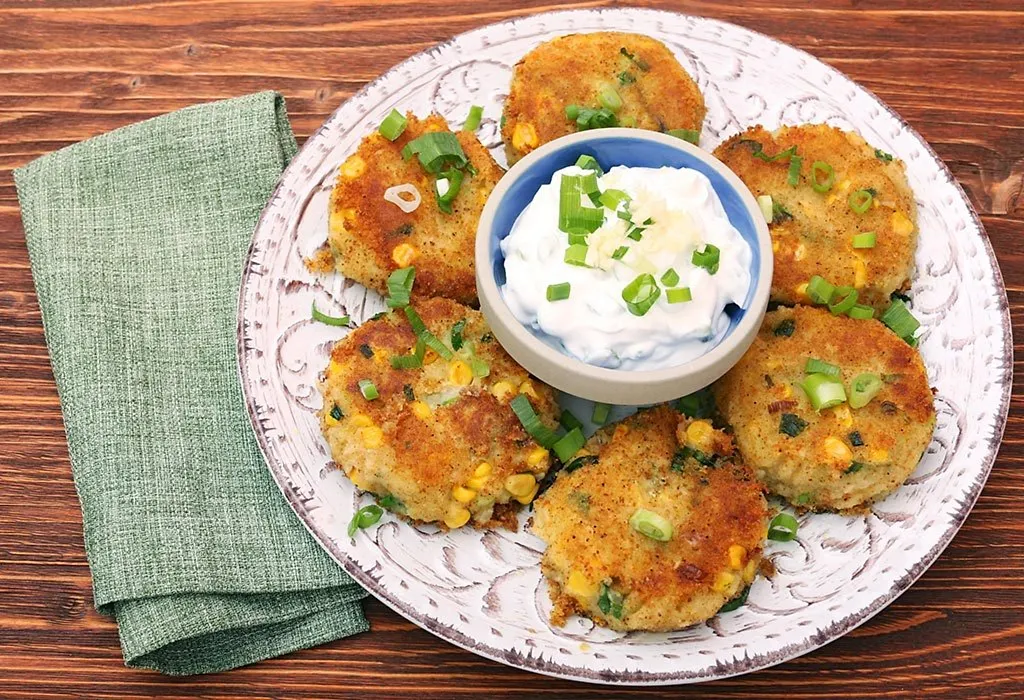
3. Tuna and Avocado Mash
This recipe combines the richness of avocado with the nutrients in tuna, perfect for babies to enjoy a creamy, nutritious meal.
Ingredients
- 1 can of low sodium light tuna
- ½ ripe avocado
- 1 tsp lemon juice
Method
- Mash the avocado in a bowl until smooth.
- Add the tuna and lemon juice, and mix thoroughly.
- Mash or puree further if needed to ensure it’s easy for your baby to eat.
FAQs
1. Can tuna be introduced as the first fish for babies?
Tuna can be introduced to babies after they have tried other common first fish options, like salmon or cod. It’s important to wait until your baby is around 6 months old and has already started eating solids. However, make sure to choose low-mercury varieties and serve in small portions to avoid any risks.
2. How often can I feed my baby tuna?
Tuna should be served in moderation due to its mercury content. For babies and toddlers, offering tuna once or twice a week is generally considered safe, depending on the type of tuna. Stick to age-appropriate portions, and be sure to vary your baby’s diet to include a range of other fish and proteins.
3. Can I mix tuna with breast milk or formula?
Yes, you can mix small amounts of tuna with breast milk or formula to make the texture smoother and easier for babies to eat, especially if they are just starting solids. This also helps introduce the new flavor gradually. However, ensure that the tuna is finely pureed or mashed to avoid choking hazards.
Tuna is a powerhouse of essential nutrients and offers several health benefits. Make sure to check if your baby can have tuna without any problems!
References/Resources:
1. Is your tuna sustainable?; United Nations; https://www.un.org/en/observances/tuna-day
2. American Academy of Pediatrics Says US Children Are Not Eating Enough Seafood; American Academy of Pediatrics; https://www.healthychildren.org/English/news/Pages/AAP-Says-US-Children-Not-Eating-Enough-Seafood.aspx
3. Bernstein. A, Oken. E, Ferranti. S, et al.; Fish, Shellfish, and Children’s Health: An Assessment of Benefits, Risks, and Sustainability (Pediatrics); American Academy of Pediatrics; https://publications.aap.org/pediatrics/article/143/6/e20190999/37157/Fish-Shellfish-and-Children-s-Health-An-Assessment; June 2019
4. Advice About Eating Fish; FDA; https://www.fda.gov/media/102331/download
5. Starting Solid Foods; American Academy of Pediatrics; https://www.healthychildren.org/English/ages-stages/baby/feeding-nutrition/Pages/Starting-Solid-Foods.aspx
6. Dietary Recommendations For Fish Consumption (A Framework for Assessing Effects of the Food System); National Library of Medicine; https://www.ncbi.nlm.nih.gov/books/NBK305180/
7. Omega-3 Fatty Acids; National Institute of Health; https://ods.od.nih.gov/factsheets/Omega3FattyAcids-HealthProfessional/
Also Read:
Fish for Babies
Salmon for Babies
Giving Chicken to Infants
Giving Garlic to Babies
Was This Article Helpful?
Parenting is a huge responsibility, for you as a caregiver, but also for us as a parenting content platform. We understand that and take our responsibility of creating credible content seriously. FirstCry Parenting articles are written and published only after extensive research using factually sound references to deliver quality content that is accurate, validated by experts, and completely reliable. To understand how we go about creating content that is credible, read our editorial policy here.







